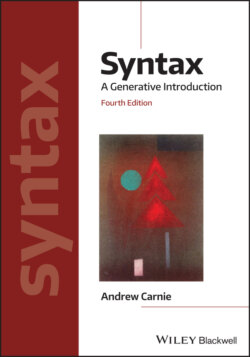Читать книгу Syntax - Andrew Carnie - Страница 35
3. OPEN VS. CLOSED; LEXICAL VS. FUNCTIONAL
Оглавление3.1 Open vs. Closed Parts of Speech
Some parts of speech allow you to add neologisms (new words). For example, imagine I invented a new tool especially for the purpose of removing spines from cacti, and I called this tool a pulfice. This kind of word is easily learned and adopted by speakers of English. In fact, we might even predict that speakers would take pulfice and develop a verb pulficize, which means to remove cactus spines using a pulfice. New words may be coined at any time, if they are open class (e.g., fax, internet, grody). By contrast there are some parts of speech that don’t allow new forms. Suppose I wanted to describe a situation where one arm is under the table and another is over the table, and I called this new preposition uvder: My arms are uvder the table. It’s fairly unlikely that my new preposition, no matter how useful it is, will be adopted into the language. Parts of speech that allow new members are said to be open class. Those that don’t (or where coinages are very rare) are closed class. All of the cases that we’ve looked at so far have been open class parts of speech.
3.2 Lexical vs. Functional
The open/closed distinction is similar to (but not identical to) another useful distinction in parts of speech. This is the distinction between lexical and functional parts of speech. Lexical parts of speech provide the “content” of the sentence. Nouns, verbs, adjectives, and adverbs are all lexical parts of speech. Functional parts of speech, by contrast, provide the grammatical information. Functional items are the “glue” that holds a sentence together. One way to tell if a lexical item is functional or lexical is to see if it is left behind in “telegraphic speech” (that is, the way a telegram would be written; e.g., Brian bring computer! Disaster looms!). Functional categories include determiners, prepositions, complementizers, conjunctions, negation, auxiliaries, and modals. We will detail some of these below in section 3.3.
You now have enough information to answer WBE6, GPS7, and CPS4.
3.3 Some Functional (Closed) Categories of English
We’ll survey here some of the main functional categories of English. This list is by no means complete. While it is possible to provide distributional definitions for various functional parts of speech, because they are closed class there are relatively few members of each class. So it is possible to simply list most of them.
We’ll start our categorization with prepositions (abbreviated P). Prepositions appear before nouns (or more precisely, noun phrases). English prepositions include the following:
12) Prepositions of English (P): to, from, under, over, with, by, at, above, before, after, through, near, on, off, for, in, into, of, during, across, without, since, until.
The class of determiners (D) is a little broader. It contains a number of subcategories including articles, quantifiers, numerals, deictics, and possessive pronouns. Determiners appear at the very beginning of English noun phrases.
13) Determiners of English (D)
1 Articles: the, a, an
2 Deictic articles: this, that, these, those, yon
3 Quantifiers:6every, some, many, most, few, all, each, any, less, fewer, no
4 (Cardinal) numerals: one, two, three, four, etc.
5 Possessive pronouns:7my, your, his, her, its, our, their
6 Some wh-question words: which, whose
You now have enough information to answer WBE7 & 8.
Conjunctions (Conj) are words that connect two or more phrases together on an equal level:
14) Conjunctions of English (Conj): and, or, nor, neither … nor, either … or
The class of complementizers (C) also connects structures together, but they embed one clause inside of another instead of keeping them on an equal level:
15) Complementizers of English (C): that, for, if, whether
One of the most important categories that we’ll use is the category of tense (T). For the moment we will not include tense suffixes such as -ed and -s in this class, and treat those as parts of verbs (we will revisit this issue in chapter 9). Instead, the category T consists of auxiliaries, modals, and the non-finite tense marker. In the older syntactic literature, the category T is sometimes called Infl (inflection) or Aux (Auxiliary). We’ll use the more modern T.
16) Tense categories of English (T)
Auxiliaries: have/has/had, am/is/are/was/were, do/does/did Modals: will, would, shall, should, can, could, may, might, must Non-finite tense marker: to
There is one special category containing only one word: not, which we’ll call negation (Neg). There are other categories that express negation (e.g., the determiners no, any, and the noun none). We’ll reserve the category Neg for the word not, however.
You now have enough information to answer WBE9 & 10, GPS8–10, and CPS5.
